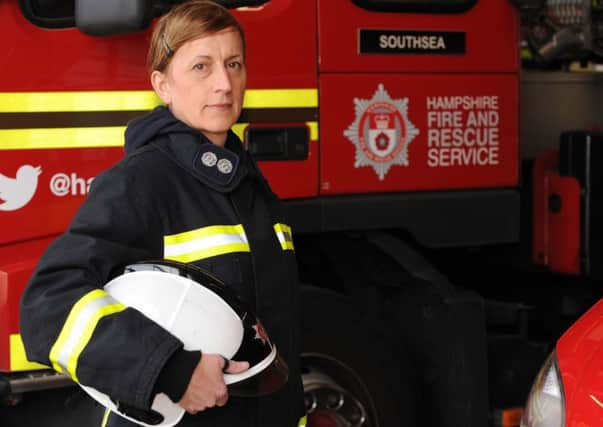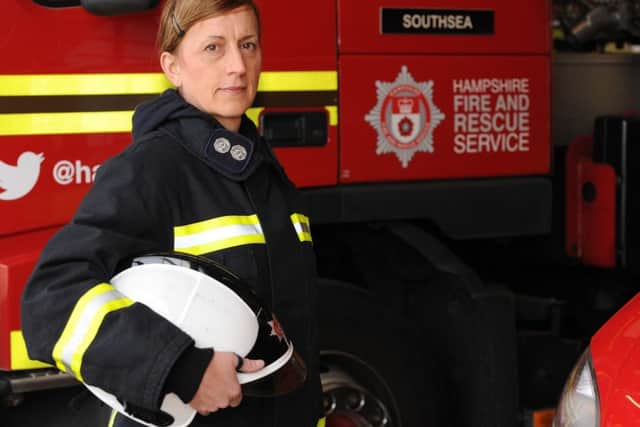'˜I just didn't feel like I fitted in'


Both roles require courage and bravery to put oneself in harm’s way.
But for father-of-two Peter Cornhill, the biggest challenge of his life was telling friends and colleagues that he’d always wanted to be a woman.
Advertisement
Hide AdAdvertisement
Hide AdNow, after undergoing gender reassignment surgery, Peter has become Katie.


Growing up as Peter, 44-year-old Southsea firefighter Katie had spent her life trapped in a man’s body.
As a child, it became normal for her to dress up in girls’ clothes, wear girls’ shoes and put on make-up.
It wasn’t until she was older that she realised she stood out and something wasn’t quite right.
Advertisement
Hide AdAdvertisement
Hide AdNow she has gone through the transition to become a woman, she looks back and sees the signs were always there.


‘I first realised there was something very different about me when I was five years old,’ she says.
‘Throughout my childhood my parents were supportive of me experimenting with my identity. They allowed me to experiment with clothes and make-up and my mum’s shoes. They used to let me wear a nightie in bed.’
She adds: ‘I got to the age of about nine or 10 and that’s when my life changed again and my parents put up a protective barrier and decided that I had to grow up as a boy.
Advertisement
Hide AdAdvertisement
Hide Ad‘I knew it was protective because my father said he knew there was something different about me.
‘It’s tough to support something different. I can remember them saying this was a phase and I would grow out of it.’
Katie recalls enjoying football and going cycling. Back then, they were stereotypically boy things.
‘But I also used to play with my sister’s dolls’ house.
‘It’s the way that society sets us up in a very binary world. People say that if you are a boy, you should wear blue and if you are a girl you should wear pink.
‘But in my brain I was conceived as a girl.
Advertisement
Hide AdAdvertisement
Hide Ad‘Society these days puts you in a box based on your physical identity before you know anything about the brain.’
School was difficult for Katie.
‘I struggled in junior school. I started to wonder ‘‘am I a boy or a girl?’’
‘In later years I didn’t feel like I fitted in. I played with the boys, but I would get ostracised by them.
‘If I played with the girls, they said “what are you doing, go and play with the boys”.
Advertisement
Hide AdAdvertisement
Hide Ad‘I can remember thinking I was attracted to girls, so I must be a boy. The whole concept of being a lesbian didn’t come into my head.
‘I knew I was attracted to females. I was visually a boy, but I had no idea how to understand that at the time.’
Things didn’t get easier when Katie moved on to secondary school.
‘The bullying continued,’ she says.
‘I had a limited number of friends. I never came out to anybody at school about my gender and my sexual identity. It was later in school that I started to understand that girls could be attracted to each other.
Advertisement
Hide AdAdvertisement
Hide Ad‘In my senior years I began to experiment more with my self-gender identity.
‘If I had an opportunity on my own I would do what is known as cross-dressing. If my parents went shopping and my brother and sister went out, I would stay at home and put on my mum’s clothes and shoes.
‘There were a few times that I nearly got caught. Nobody knew that I was doing it. I lived a very gender fluid life.’
When Katie was a teenager, she became a sea cadet.
‘It was an amazing place,’ she says.
‘I didn’t tell anybody about my gender identity and I didn’t get bullied for who I was. I was always able to just be me and get on with what I was doing.’
Advertisement
Hide AdAdvertisement
Hide AdIt was there that Katie developed an interest in the forces. She went on to spend six years serving in the Royal Marines.
‘While I was in the Royal Marines, I met my ex-wife,’ she says.
‘After about a year I told her about who I wanted to be. I showed her a box with make-up, a wig, and shoes – things that I would wear as a female.’
The pair married in 1995, before splitting up in 2005.
‘We had concerns in the early years about me and my gender identity. We were being protective of me as an individual and our relationship and people around us.
‘She allowed me to express who I am in a gender fluid way.’
Advertisement
Hide AdAdvertisement
Hide AdTogether, the couple told a few friends and Katie’s twin brother, Sean. They began to go out together, with Katie as herself.
‘I was only able to be myself when I was at home or out with my brother. He understands that I am just who I am as a person.’
Katie and her ex-wife have two children together – Tayla, who is 17 and, Millie, who is 12.
‘My eldest daughter is amazingly supportive of me,’ Katie adds.
Advertisement
Hide AdAdvertisement
Hide AdKatie hasn’t seen her youngest daughter for a few years now, but knows she is keen to make contact and be involved in her life again.
In 1996, Katie joined the fire service. It was around eight years ago that she first started to explore the idea of becoming a woman and how that would impact on her career.
She discovered the Fire Brigade LGBT Union who have supported her on her journey.
‘That’s where I first came out and started to explore how I would do this,’ she says.
Advertisement
Hide AdAdvertisement
Hide Ad‘For me it was a really challenging proposition. I had to think about my career in the fire service and whether it was something I could do.’
Katie began the transition in 2012 by going for a psychological assessment to enable doctors to identify what is known as gender dysphoria. She had to live as a female for two years before she was able to start the process, which involved taking hormone tablets.
And in November last year, she underwent gender reassignment surgery, and officially had the female organs she had always wanted.
She is now loving life as a Fire Safety Inspector for Hampshire Fire and Rescue Service.
Advertisement
Hide AdAdvertisement
Hide Ad‘I am extremely happy. I have an amazing group of friends and family who love me.’
RAISING AWARENESS
Katie Cornhill now does a lot of work within schools, sharing her story and raising awareness of issues surrounding gender identity.
She is also promoting inclusion across the workplace, to make it easier for people to feel more comfortable in their surroundings.
‘There’s a strong need for all workplaces to be more inclusive,’ she says.
Advertisement
Hide AdAdvertisement
Hide Ad‘We have now got an education system that allows younger people to express themselves.
‘It’s important for us to get it right in the workplace too. If there’s an inclusive, safe environment, people can be themselves and perform at their best.’
Katie is a trustee for Stonewall - a gay, lesbian, bisexual and trans people charity. She also founded Quiltbag – a UK Fire and Rescue Service LGBT network, which enables people within the service who aren’t members of the FBU to seek help and support.
To find out more, visit quiltbagfire.co.uk.